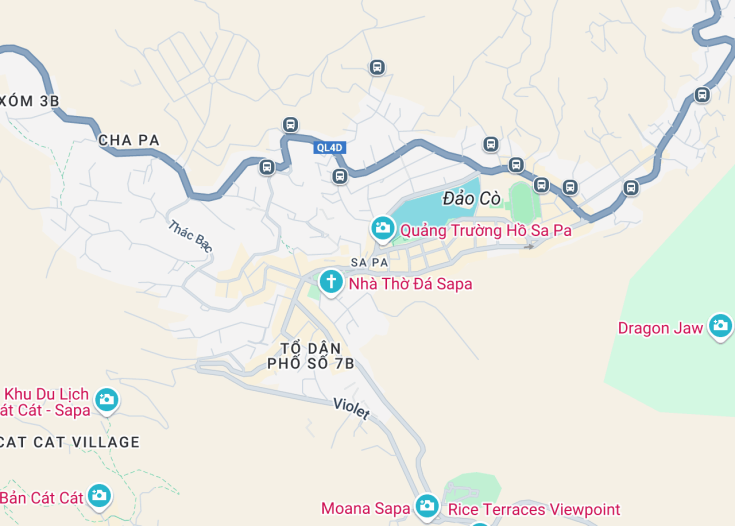Nestled in the rugged terrains of northern Vietnam, Sa Pa is a breathtaking mountain town known for its dramatic landscapes and cultural richness. This former French hill station is encircled by towering peaks, lush terraces that paint the hills in shades of green, and a patchwork of minority cultures that add vibrant layers to its serene natural beauty.Visitors are drawn to Sa Pa for its unique opportunity to experience a convergence of cultural diversity and scenic splendour.
Before visiting Sa Pa, consider timing your trip to coincide with the local markets, where ethnic minorities wearing traditional attire sell unique handcrafted goods.
Equip yourself with comfortable hiking gear to fully embrace the numerous trekking opportunities that Sa Pa offers, exploring its majestic valleys and remote villages.
Top things to do & see in Sa Pa
Select the following sights and activities to discover best tickets and tours available in Sa Pa.
Sa Pa: The Picturesque Mountain Town
| Country | Vietnam |
| Time in Sa Pa | GMT+7 |
| Language spoken | Vietnamese |
| Population | 56,000 (source: Vietnam National Administration of Tourism, 2023) |
| Currency | Vietnamese Dong (₫, VND) |
| Airports |
|
Sa Pa, located in the mountainous region of northern Vietnam, is renowned for its dramatic landscapes and rich cultural heritage. Nestled in the Hoàng Liên Son Mountains and overlooking the sculpted rice terraces of the Muong Hoa Valley, Sa Pa is a town where modernity meets traditions with the local ethnic tribes, including the Hmong, Dao, and Tay, contributing significantly to the region’s unique character.
Where is Sa Pa?
Sa Pa is situated in the Lao Cai Province, far north of Vietnam, near the border with China.
Distances:
| Route | Distance by car | Time by car |
|---|---|---|
| Hanoi to Sa Pa | 195 miles (314 km) | approximately 5 hours |
| Hai Phong to Sa Pa | 240 miles (386 km) | approximately 6.5 hours |
What is Sa Pa famous for?
Sa Pa is famous for its stunning landscapes, ethnic diversity, and rich agricultural practices that produce the iconic terraced rice fields. Its cool climate and rich cultural festivals draw tourists from around the world.
History
Before the 1900s
The history of Sa Pa traces back to its indigenous beginnings when the area was mostly inhabited by ethnic groups such as the H’Mong, Dao, and Tay. This region, embedded deep within the mountainous terrains of Northern Vietnam, remained largely isolated from the mainstream developments of the Vietnamese kingdoms due to its rugged topography.
French Colonial Era (1880s – 1954)
During the French colonization of Vietnam, Sa Pa was developed as a hill station in the early 1900s by the colonists to serve as a retreat from the tropical climate of the lowlands. The French introduced their architecture and urban planning, establishing churches, villas, and gardens, remnants of which are evident even today. They also laid the foundations for its development as a tourist destination, appreciating its cool climate and scenic mountainous landscapes.
Post-Colonial Development (1954 – 2000)
After Vietnam’s independence from French colonial rule, Sa Pa experienced a period of relative obscurity. The region suffered during the Vietnam War due to its proximity to the Chinese border, facing several strategic challenges. Post-war, the area slowly began to regain its appeal as a serene escape from bustling city life. It wasn’t until the late 1990s that Sa Pa re-emerged as a significant tourist destination, facilitated by the Vietnamese government’s initiatives to promote tourism as a national economic strategy.
The Modern Era (2000 – Present)
In recent years, Sa Pa has transformed considerably with modern infrastructure developments including better road connections, accommodations, and tourist facilities, becoming one of Vietnam’s most visited destinations. The town has also become a center for cultural exchange, showcasing the rich heritage of the local ethnic communities through various cultural and tourism activities. However, this rapid development has also raised concerns about environmental impact and cultural sustainability.
Visit Sa Pa
What to see and do in Sa Pa
Exploring Sa Pa offers a blend of cultural and natural attractions:
- Visit the Sa Pa Market, a vibrant hub where local ethnic communities sell crafts and produce.
- Take a trek through the lush rice terraces, particularly in the Muong Hoa Valley, known for its breathtaking landscapes.
- Ascend Fansipan, the highest peak in Vietnam, accessible via a challenging hike or a cable car ride.
- Explore the traditional villages of Cat Cat and Ta Phin, where you can experience the rich culture of the H’Mong and Dao people.
Festivals and Events in Sa Pa
Sa Pa is renowned for its vibrant festivals, particularly:
- The Sa Pa Love Market, an age-old cultural tradition held every Saturday where ethnic youths meet and express their feelings through songs and dances.
- The Lunar New Year (Tet) celebrations, involving colorful displays and local customs in January or February.
Best time to visit Sa Pa
For the best weather, visit Sa Pa during either spring (March to May) or autumn (September to November). These seasons boast moderate temperatures and clearer skies, ideal for trekking and exploring the outdoors.
Is Sa Pa worth visiting?
Sa Pa is undoubtedly worth a visit for those who cherish nature and culture. It offers a rare combination of sublime natural beauty, intriguing cultural heritage, and a cool, refreshing climate, making it a unique destination on the map of Vietnam.
Whether you’re an avid trekker, culture enthusiast, or simply a traveler seeking tranquility away from the hustle and bustle of urban life, Sa Pa provides a memorable experience enriched with the warm hospitality of its local communities.









